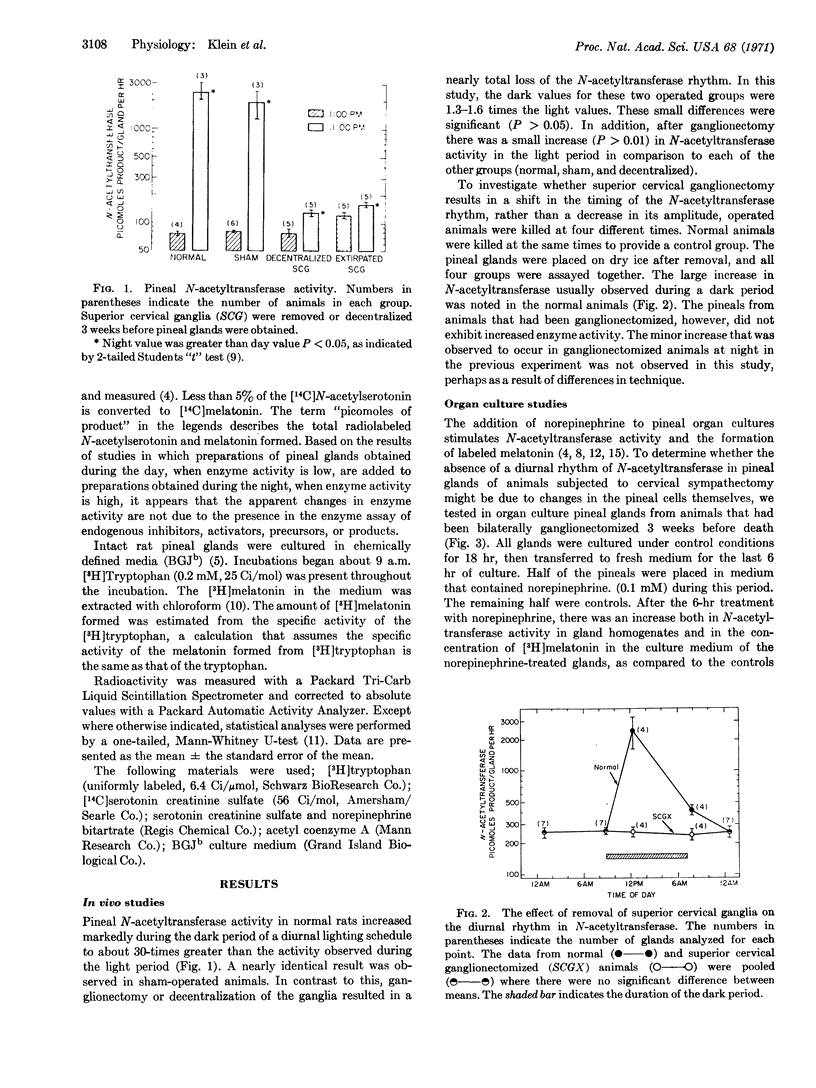Abstract
There is a diurnal rhythm in the activity of serotonin N-acetyltransferase in the rat pineal gland. In the normal rat, the nocturnal enzyme activities are 15-to 30-fold greater than are daytime activities. This rhythm is abolished by decentralization or removal of the superior cervical ganglia, procedures that interrupt the only source of central neural input to the pineal gland. This effect of superior cervical sympathectomy on the N-acetyltransferase rhythm cannot be attributed to changes occurring in the denervated pineal parenchymal cells. When chronically denervated glands are placed in organ culture with norepinephrine, the neurotransmitter normally located in sympathetic terminals in the gland, N-acetyltransferase activity increases 10- to 20-fold. These data indicate that superior cervical sympathectomy abolishes the N-acetyltransferase rhythm by elimination of the input of central signals to the gland. These signals appear to regulate the N-acetyltransferase rhythm in the normal rat by regulation of the release of norepinephrine from the sympathetic terminals within the pineal gland.
Keywords: rat, diurnal rhythm, melatonin, N-acetylserotonin, organ culture, circadian enzyme regulation
Full text
PDF



Images in this article
Selected References
These references are in PubMed. This may not be the complete list of references from this article.
- AXELROD J., WEISSBACH H. Purification and properties of hydroxyindole-O-methyl transferase. J Biol Chem. 1961 Jan;236:211–213. [PubMed] [Google Scholar]
- Axelrod J., Shein H. M., Wurtman R. J. Stimulation of C14-melatonin synthesis from C14-tryptophan by noradrenaline in rat pineal in organ culture. Proc Natl Acad Sci U S A. 1969 Feb;62(2):544–549. doi: 10.1073/pnas.62.2.544. [DOI] [PMC free article] [PubMed] [Google Scholar]
- FISKE V. M. SEROTONIN RHYTHM IN THE PINEAL ORGAN: CONTROL BY THE SYMPATHETIC NERVOUS SYSTEM. Science. 1964 Oct 9;146(3641):253–254. doi: 10.1126/science.146.3641.253. [DOI] [PubMed] [Google Scholar]
- KAPPERS J. A. The development, topographical relations and innervation of the epiphysis cerebri in the albino rat. Z Zellforsch Mikrosk Anat. 1960;52:163–215. doi: 10.1007/BF00338980. [DOI] [PubMed] [Google Scholar]
- Klein D. C., Berg G. R. Pineal gland: stimulation of melatonin production by norepinephrine involves cyclic AMP-mediated stimulation of N-acetyltransferase. Adv Biochem Psychopharmacol. 1970;3:241–263. [PubMed] [Google Scholar]
- Klein D. C., Berg G. R., Weller J. Melatonin synthesis: adenosine 3',5'-monophosphate and norepinephrine stimulate N-acetyltransferase. Science. 1970 May 22;168(3934):979–980. doi: 10.1126/science.168.3934.979. [DOI] [PubMed] [Google Scholar]
- Klein D. C., Weller J. L. Indole metabolism in the pineal gland: a circadian rhythm in N-acetyltransferase. Science. 1970 Sep 11;169(3950):1093–1095. doi: 10.1126/science.169.3950.1093. [DOI] [PubMed] [Google Scholar]
- Klein D. C., Weller J. Input and output signals in a model neural system: the regulation of melatonin production in the pineal gland. In Vitro. 1970 Nov-Dec;6(3):197–204. doi: 10.1007/BF02617764. [DOI] [PubMed] [Google Scholar]
- Lynch H. J. Diurnal oscillations in pineal melatonin content. Life Sci I. 1971 Jul 15;10(14):791–795. doi: 10.1016/0024-3205(71)90033-6. [DOI] [PubMed] [Google Scholar]
- QUAY W. B. CIRCADIAN AND ESTROUS RHYTHMS IN PINEAL MELATONIN AND 5-HYDROXY INDOLE-3-ACETIC ACID. Proc Soc Exp Biol Med. 1964 Mar;115:710–713. doi: 10.3181/00379727-115-29014. [DOI] [PubMed] [Google Scholar]
- Reiter R. J., Fraschini F. Endocrine aspects of the mammalian pineal gland: a review. Neuroendocrinology. 1969;5(3):219–255. doi: 10.1159/000121862. [DOI] [PubMed] [Google Scholar]
- Reiter R. J., Sorrentino S., Jr, Ralph C. L., Lynch H. J., Mull D., Jarrow E. Some endocrine effects of blinding and anosmia in adult male rats with observations on pineal melatonin. Endocrinology. 1971 Apr;88(4):895–900. doi: 10.1210/endo-88-4-895. [DOI] [PubMed] [Google Scholar]
- SNYDER S. H., ZWEIG M., AXELROD J., FISCHER J. E. CONTROL OF THE CIRCADIAN RHYTHM IN SEROTONIN CONTENT OF THE RAT PINEAL GLAND. Proc Natl Acad Sci U S A. 1965 Feb;53:301–305. doi: 10.1073/pnas.53.2.301. [DOI] [PMC free article] [PubMed] [Google Scholar]
- Volkman P. H., Heller A. Pineal N-acetyltransferase activity: effect of sympathetic stimulation. Science. 1971 Aug 27;173(3999):839–840. doi: 10.1126/science.173.3999.839. [DOI] [PubMed] [Google Scholar]
- WOLFE D. E., POTTER L. T., RICHARDSON K. C., AXELROD J. Localizing tritiated norepinephrine in sympathetic axons by electron microscopic autoradiography. Science. 1962 Oct 19;138(3538):440–442. doi: 10.1126/science.138.3538.440. [DOI] [PubMed] [Google Scholar]
- Wurtman R. J., Axelrod J., Fischer J. E. Melatonin Synthesis in the Pineal Gland: Effect of Light Mediated by the Sympathetic Nervous System. Science. 1964 Mar 20;143(3612):1328–1329. doi: 10.1126/science.143.3612.1328. [DOI] [PubMed] [Google Scholar]
- Wurtman R. J., Axelrod J., Sedvall G., Moore R. Y. Photic and neural control of the 24-hour norepinephrine rhythm in the rat pineal gland. J Pharmacol Exp Ther. 1967 Sep;157(3):487–492. [PubMed] [Google Scholar]




